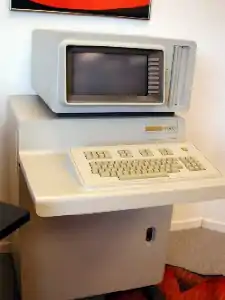HP 300
The HP 300 "Amigo" was a computer produced by Hewlett-Packard (HP) in the late 1970s based loosely on the stack-based HP 3000, but with virtual memory for both code and data. The HP300 was cut-short from being a commercial success despite the huge engineering effort, which included HP-developed and -manufactured silicon on sapphire (SOS) processor and I/O chips.

The HP300 was initially designed as a single-user workstation by a totally separate program within the General Systems Division (GSD), the Cupertino, California home of the HP 3000 business computers (the division was later renamed Computer Systems Division CSY). Later, the HP300 design team developed multi-user abilities, and an ahead of its time inter-unit processor interconnect that let one HP300 change registers in other inter-connected HP300's system.
Features
The circuit boards were in a floor pedestal box, with CRT on top with built-in soft keys, and fixed keyboard protruding in front. It pioneered such ideas as built-in networking, automatic spelling correction, multiple windows (on a character based screen), and labels adjacent to vertically stacked user function keys, now used on ATMs and gas pumps. The HP300 featured HP-IB (later IEEE-488) interface (IF) as the I/O bus, an 8" floppy disk, and a built-in fixed 12M hard drive. Later drivers for HP7970E tape drive allowed for easier HP300 system back ups. It also had a native system programming language, a database, BASIC, and featured screen editing for RPG.
Production
HP Computer Systems Division General Manager (GM), Doug Spreng, decided the file system differences between the division's money making HP3000 line and the burgeoning HP300 would keep the HP300 from being successful and killed the product. HP built two semi-truck loads of units before shutting down the HP300 production line to meet customer contractual agreements (i.e.: in case LLNL wanted more Amigos).
Design reuse
HP commonly reused the work of killed products in other product designs to save money and keep design-team morale up. The processor board and I/O boards were used in later HP 3000 systems that used the HP300's advanced designs: HP3000 model 30 (project name: Koala - a single card bay stand-alone box) and model 33 (project name: Toothpick - a double card bay table design) reused many of HP300's designs. The HP300 diagnostics (DUS) were ported over and used in these and future HP3000 models.
Later, the HP300 design team over came the first generation HP300 slower TTL circuitry with a SOS design (project name: Sizzler). Again the GM killed its release and reused its designs in a new HP3000 model 40 (project name: Cub - single card bay stand-alone box) and the model 44 (project name: Grizzly - double card bay table design).
The HP3000 models 30, 33, 40, 44, 42, & 48 went on to great success using what was developed in the HP300. The HP300's change to one (at the time) high speed interface HP-IB channel from HP3000's previous use of many different type internal IF cards radically changed and improved future HP system designs.
Developed about the same time in Loveland CO, then later in the same GSD Cupertino site, the HP 250 small business system running an easy to use HP250 Business Basic language to access HP's Image Database, was based on the HP9845 workstation using a HP Loveland calculator processor. The built-in CRT head with softkeys and the embedded keyboard design removed from the HP300 was reused in the HP250 table-top designs.
References
- Davis, Steve (1979-09-01). "European 2631A Users Beware!" (PDF). Computer Systems Newsletter - for HP Field Personnel. Hewlett-Packard. 4 (20): 4. Archived (PDF) from the original on 2016-08-17. Retrieved 2016-08-17.
009 - Roman Extension Set […] option 009 gives all the commonly used European characters a unique code. When this "Roman Extension" set is used in conjunction with the standard ASCII character set, the end result is a 256 character set represented by 8-bit code. The use of shift-in and shift-out characters is not required, since decimal codes 0 through 127 automatically access USASCII while codes 128 through 255 access the European characters. It IS Important to understand the differences between the two techniques and to know whlch technlque IS supported on a glven system. The HP 250 and HP 300 support the 8-bit code technlque, consequently, 2631A option 009 must be ordered to provlde local language prlntlng on these two systems. All other HP computer systems and the 264X terminals support the 7-bit code, shift-in/shift-out method.
External links
- "misc" (PDF). Hewlett-Packard Journal. Hewlett-Packard. 30 (6). June 1979. Archived (PDF) from the original on 2016-08-17. Retrieved 2016-08-17. (HP300 hardware and software details are described)
- "misc" (PDF). Hewlett-Packard Journal. Hewlett-Packard. 30 (7). July 1979. Archived (PDF) from the original on 2016-08-17. Retrieved 2016-08-17. (HP300 hardware and software details are described)
- hpmuseum.net: HP Computer Museum HP300 page